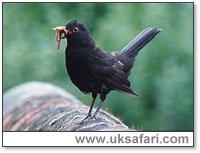
|

|
|
 Sent
to you Sent
to you
by e-mail
|
|
Simply
enter your details and hit the send button
more
info |
|


Click Here

Links
Advertise
Terms of Use
Contributors
About Us
Contact Us
|
 |
Go back
 | Bookmark
| Bookmark
 | Print Page
| Print Page  | E-Mail Us
| E-Mail Us 
 

Photo: G. Bradley |
|
UK
Safari Tip:
Get help identifying birds with the superbly illustrated "Top 50
Garden Birds" identification chart - click
here
|
|
Latin name: Turdus merula
Size: Up to 25cms.
Distribution: Found throughout the UK.
Months seen: All year round
Habitat: Gardens and open countryside.
Food: Worms, insects, fruit and berries.
Special features: The male bird has black plumage, yellow beak, and a narrow yellow ring around the eye. The female has dark brown coloured plumage, and a darker coloured beak. Young male blackbirds also have darker coloured beaks in their first year, and while most of the plumage is black, their wings are brown.
To confuse things, albino and semi-albino blackbirds also occur. Some birds have a few white feathers, while some blackbirds are totally white.
Although most blackbirds remain in the UK all year, every autumn large numbers fly in from Northern Europe to swell the resident population.
 Hear a Blackbird Singing
Hear a Blackbird Singing
• Click
here for the MP3 - 191 KB
• Click
here for the WAV - 1.03MB
Blackbirds pair up in February, and as soon as the bushes begin greening up with foliage, nest building starts. The nest is made from grass and mud, and can be built in a hedge, bush or tree. Between three and six eggs are laid, which are
greeny-blue with light brown speckles.
The eggs hatch within two weeks, and within a further two weeks the baby birds have left the nest. They remain on the ground, close to the nest site, and the parents continue to feed them until they are able to fly. At this time the baby birds are most vulnerable to predators such as domestic cats and
foxes.

UK Safari Bird Section
White blackbirds
Blackbird Nest
|
 |

|